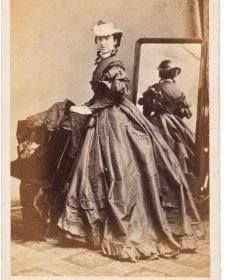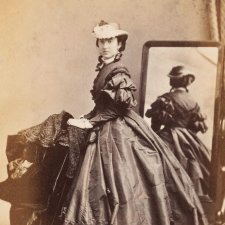This photograph shows Catholic priests from the diocese of Adelaide, formed in 1842 by the subdivision of the diocese of Sydney. South Australia’s first Catholic church was built in Adelaide in 1845, and by 1851 a community of Austrian Jesuits had established the town of Sevenhill in the Clare Valley. The Jesuits opened a winery there and in 1856 founded St. Aloysius College – South Australia’s first Catholic school. In the 1860s, with the growth in the colony’s Catholic population, the church began establishing charitable institutions, such as the St Vincent de Paul Orphanage in 1866. That year, at Penola, Mary MacKillop and Father Julian Tenison Woods founded the Sisters of St Joseph of the Sacred Heart. The order worked to provide education for disadvantaged children and within four years their activities had expanded to 21 schools in Adelaide and regional areas. Although it is not yet known which particular event may have occasioned this group portrait, each of the sitters depicted here were significant to the consolidation of the Catholic church and of its social welfare and educational work in South Australia. Shown in the back row (left to right) are: the Very Reverend John Smyth, Vicar General of South Australia (1824–1870); the Reverend Frederick Byrne (1834–1915); the Venerable Archdeacon Patrick Russell (1828–1902); an unidentified priest, possibly Reverend Michael O'Brien; and the Reverend Christopher Augustine Reynolds (1834–1893), who was appointed Bishop of Adelaide in 1873 and Archbishop of Adelaide in 1887. In the front row, left to right are: the Reverend Dean Daniel Fitzgibbon (1833–1876); Reverend Maurice Lencioni (1814–1864); Reverend Simon Carew (life dates unknown); and Reverend Peter Hughes (1820–1876).
Photographer Stephen Nixon was born in Birmingham in 1842 and came to South Australia in 1855 with his parents and several siblings. His father, William Millington Nixon, was also a photographer, and on arriving in Adelaide began working with the American-born brothers Townsend and Sanford Duryea. The partnership was dissolved in 1860, after which Nixon senior appears to have worked itinerantly in towns around the border between South Australia and New South Wales. Stephen Nixon and his brothers Joseph and Samuel opened a studio at Kapunda in 1862, but they also appear to have travelled throughout South Australia during the remainder of the decade. ‘Nixon Brothers, photographic artists’ were reported as having supplied some ‘photographic views’ of Angaston in 1863; in late 1864, Stephen Nixon was in Macclesfield, then Milang, and was back in Kapunda in 1865. In winter 1866, with his new ‘superior instruments’ imported from England, Nixon guaranteed to produce ‘as Good and Satisfactory a Portrait during Dull Weather as he has hitherto been able to accomplish in Bright Sunshine, and Equal to anything taken in the Colony.’ Also available were views of Kapunda and ‘a good assortment of Aboriginal Portraits.’ His cartes de visite at this time were twelve shillings and sixpence per dozen. In the early 1870s Nixon was in Moonta and Kadina; at one point he had ‘pitched his tent’ at Yorketown, where, ‘judging from the exhibits’ it was expected he could not fail ‘to command the patronage of the public.’ In 1875, he purchased Townsend Duryea’s business in King William Street, Adelaide. Between about 1880 and 1886 Nixon crops up in Kadina, Yorketown, Tanunda and then Kapunda again, where his son Charles joined the business. Nixon appears to have retired when Charles – the only one of his ten children to take up photography – moved to Fremantle in 1893.
Purchased 2018



On one level The Companion talks about the most famous and frontline Australians, but on another it tells us about ourselves.



Drawn from the NPG’s burgeoning collection of cartes de visite, Carte-o-mania! celebrates the wit, style and substance of the pocket-sized portraits that were taken and collected like crazy in post-goldrush Australia.



Visit us, learn with us, support us or work with us! Here’s a range of information about planning your visit, our history and more!